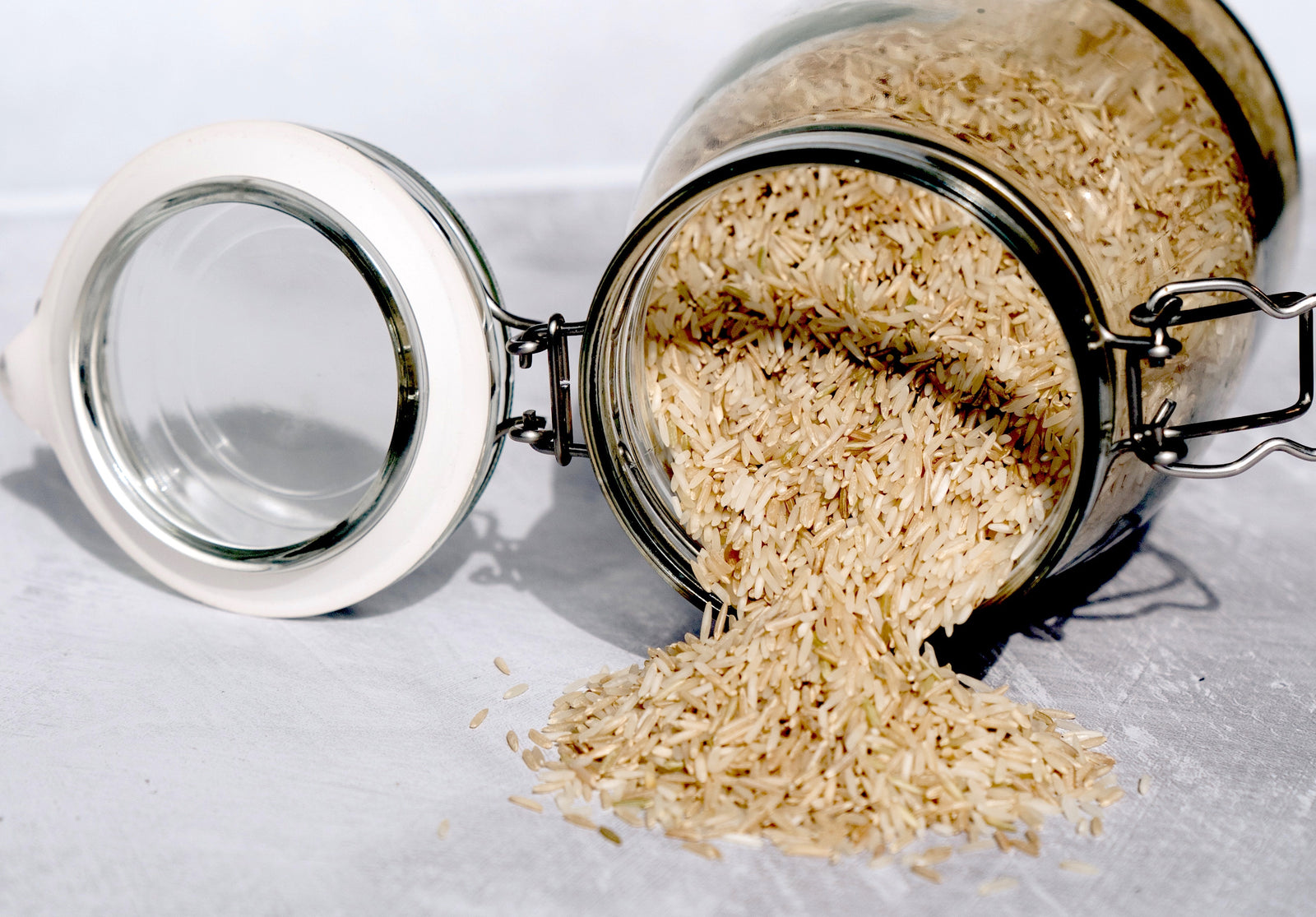There are literally thousands of varieties of rice out there in the world, but today, we’re going to focus on two common ones here in the states: basmati rice vs brown rice. If you’re looking for some general information or are looking to reap maximum results from your nutrition, you’ve come to the right place. Rice is relatively cheap and is filling, however it doesn’t have too much flavor on it’s own. What should the choice come down to? Your goals and the nutritional content. Let’s see which one, basmati rice vs brown rice, will be the winner that helps you stay on track with your goals!

Basmati Rice
Basmati rice is a long-grain, very aromatic brown or white rice. Originally derived from India, the nutty (and sometimes even spicy) aroma that comes through when cooking is from a unique compound specific to basmati rice called 2-acetyl-1-pyrroline. When you cook the rice, most of the aroma comes out of the rice as the 2-acetyl-1-pyrroline releases in the process. Desire to keep it around? Soak your rice for 20 minutes or more prior to cooking it. This is done to not only keep the aroma, but it also shortens the overall cooking time in half.
Is Basmati Rice Gluten Free: Yes
Fun Fact: Nearly 65% of the worlds basmati rice production is exported from India with a majority of the remaining percentage produced from Pakistan. That being said, there are small crops and other hybrids available from places like Nepal, Indonesia, Kenya and Texas.

Brown Rice
Brown rice is a very common rice here in the US and its available in both short- and long-grain varieties. To produce brown rice, the husk (outermost layer) is removed to expose the bran. The layer of bran is responsible for giving off that nutty, brown rice aroma, and giving brown rice it's sort of chewy and thick texture.
Is Brown Rice Gluten Free: Yes
Fun Fact: Brown rice comes from the processing procedure before white rice, and in order to get white rice, manufacturers remove both the bran and the layers underneath. This is why white rice is softer and less chewy than brown rice when cooked.
Nutrition Facts: Basmati Rice vs Brown Rice
You’ll see below some of the nutrition facts differences between basmati and brown rice. You’ll notice that while brown rice has more calories from fat, it does contain a few more grams of dietary fiber and potassium which can cause a feeling of fullness for longer as compared to basmati. That being said, the differences aren’t that major, so at this point in the basmati rice vs brown rice competition, the two are still pretty evenly stacked.
Basmati Rice |
Brown Rice |
|
Calories – 205 |
Calories – 218 |
|
Calories from Fat – 4 |
Calories from Fat – 14.6 |
|
Total Fat – 0.4 g |
Total Fat – 1.6 g |
|
Sodium – 1.6 mg |
Sodium – 2 mg |
|
Potassium – 55 mg |
Potassium – 154 mg |
|
Total carbs – 45 g |
Total carbs – 46 g |
|
Dietary Fiber – 0.6 g |
Dietary Fiber – 3.6 g |
|
Protein – 4.3 g |
Protein – 4.6 g |
|
Calcium – 19.5 mg |
Calcium – 19.5 mg |
|
Iron – 1.9 mg |
Iron – 0.8 mg |
|
Magnesium – 72 mg |
Magnesium – 83.9 mg |
|
Phosphorus – 150 mg |
Phosphorus – 162 mg |
|
Copper – 0.2 mg |
Copper – 0.2 mg |
|
Manganese – 1.9 mg |
Manganese – 1.8 mg |
|
Selenium – 11.8 mcg |
Selenium – 19.1 mcg |
|
Thiamin – 0.26 mg |
Thiamin – 0.2 mg |
|
Niacin – 3.2 mg |
Niacin – 3.0 mg |
|
Vitamin B6 – 0.4 mg |
Vitamin B6 – 0.3 mg |
Basmati Rice Nutrition Facts
Unlike brown rice, basmati rice doesn’t offer much in the way of fiber. It also offers a few essential amino acids which carbohydrates and protein metabolize well.

Some basmati rice may be enriched, meaning that certain nutrients are added during the manufacturing process to boost the nutritional value. [R] In particular, rice and other grains are often enriched with iron and B vitamins like folic acid, thiamine, and niacin [R].
Is Basmati Rice Good For You
Yep, the nutrition facts say so, and we believe it to make a great addition to a dish, meal prep, or on the side of just about any meat. When looking at the basmati rice health benefits compared to other types of rice, basmati is generally lower in arsenic. Arsenic is a heavy metal known to hurt the health of humans and potentially increase the risk of diabetes, heart problems, and certain cancers. [R] It’s versatile and delicious, but is basmati rice healthy? Yep, especially brown basmati rice. If you choose brown basmati rice over white, it’s considered to be a whole grain. This means it contains all three parts of the kernel — the germ, bran, and endosperm — offering a higher nutrient content.
Brown Rice Nutrition Facts
Brown rice is unique in that it offers up both soluble and insoluble fiber. The soluble fiber helps slow down digestion to maximize absorption while insoluble fiber moves food along the GI, promotes digestion, absorption, and reduces constipation.

Here’s some more brown rice nutrition info for you -- brown rice, like basmati, contains all eight essential amino acids, is gluten-free, has no cholesterol, and is a great way to provide energy and minerals essential to human function and performance. [R] Also, basmati rice carbs are just about the same, whereas the difference comes down to the nutrient content of the rice rather than just the macros.
Fun Fact: High-quality basmati rice undergoes a two-year aging process to dry it out as thoroughly as possible.
Is Brown Rice Good For You
While you might be wondering if brown rice is good for you, you might also be wondering is brown rice healthy for you? Definitely! Since brown rice is a whole grain and is considered a low glycemic food, it can be a nutritious addition to your lifestyle. Brown rice also makes a more healthful choice than white rice and is less likely to contribute to negative health consequences such as type-2 diabetes. You can substitute it in any recipe that calls for white rice which makes it an easy swap for most people.

Basmati Rice vs Brown Rice Glycemic Index
The glycemic index is a scale that goes from 1 to 100. It’s used in the food world to put a number on how the body handles the sugar content of a specific food. The lower the food is on the scale, the lower the sugar levels/content the food item has. If you eat a lot of foods that are higher on the scale, you can give your blood sugar levels a roller coaster ride. This is also what causes type 2 diabetes. [R]
When comparing basmati rice vs brown rice on the glycemic index, they’re pretty similar. [R] It’s important to note that the way the rice is prepared as well as the foods eaten along with it can influence the GI of a food. By incorporating low glycemic index foods, like basmati or brown rice, you can keep blood sugars level.
- Basmati rice (low – medium)
- Brown rice (low – medium)
- White rice (high)
- Jasmine rice (medium – high)
- Black rice (low – medium)
Fun Fact: This is why you see bodybuilders eating lean protein and rice – its ideal for bulking up with quality muscle while keeping body fat to a minimum thanks to the balance in blood sugar.
Basmati Rice Whole Grain vs Basmati Rice Long Grain
Wondering about white or brown basmati rice? Brown basmati rice is considered a whole grain in a lot of the same ways brown rice is compared to white rice. Many of the nutrient properties aren’t stripped in the manufacturing process, however, its important to note that while white basmati rice has less fiber (because the outer shell has been removed) there is still a nice nutritional profile and easier digestibility. Some will argue that any type of brown rice is better than white rice, but ultimately, it should come down to the factors that influence your own personal health – cost, digestibility, fiber content, nutrients, and taste.

Arsenic Levels In Rice
Arsenic is one of the worlds most toxic elements and it infiltrates its way into our foods, especially rice. As a staple part of our food intake, this is a concern and something food manufacturers and producers are watching closely. But is it enough for you to be worried?
There are two different types of arsenic compounds [R]:
- Organic Arsenic: mainly found in plant + animal tissues
- Inorganic Arsenic: found in rock, soil, or water (more toxic form)
Why is arsenic in your rice? Think about the growing process -- the paddy rice fields are flooded with water and polluted groundwater is one of the biggest sources of arsenic. [R] While yes, arsenic is naturally present in rocks and waters, human activities (pesticides, wood preservatives, fertilizers, industrial waste, mining, smelting, coal burning, etc.) increase these levels dramatically. Rice is one of the foods that absorbs more arsenic from water and soil as compared to other food crops. [R]
So should you be worried?
You should definitely be aware of it but not really worried. You definitely don’t need to avoid rice, but rather, have it in moderation and pair it with other nutrient dense foods. You can take additional steps in the cooking process to reduce arsenic content such as:
- Use lots of water when cooking any type of rice (6:1 ratio water to rice, can reduce arsenic content up to 57% [R])
- Thoroughly rinse your rice before cooking it (can remove 10-28% of arsenic [R])
- Choose rice from California, North India, Nepal or Pakistan (lower levels) [R, R]
- Consider eating different varieties of rice (basmati typically has lower levels than brown)

The Bottom Line
The type of rice that you include in your diet comes down to your own preference. What do you want the taste, texture, and cost of your rice to be? Whatever your goal is, we do recommend using a rice that is lower on the glycemic index to keep your blood sugar levels in check. In our opinion, whatever rice is going to support your health, physical, and performance goals is the best one to go with. Just don’t forget to wash it and cook it with lots of water to reduce the heavy metal content and you’ll be golden!

SWOLVERINE IS AN ENDURANCE ATHLETE AND ACTIVE LIFESTYLE BRAND. MADE FOR THE ELITE ATHLETE, AND THE STRONG-WILLED OUR PRODUCTS WERE DESIGNED TO FUEL YOUR ATHLETIC PERFORMANCE. WE PERFORM WHEN YOU PERFORM.
We believe that everyone can optimize not only their athletic performance but their human potential. The way we believe we can optimize performance is through transparency, clinically effective doses, and clinically proven ingredients with evidence-based outcomes. We provide the nutrients you need to power your active lifestyle.
Find similar articles:
Nutrition






